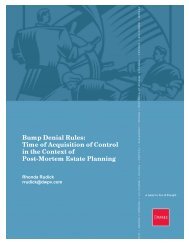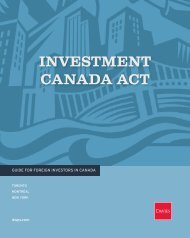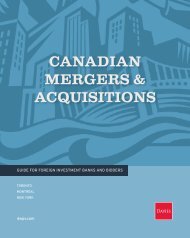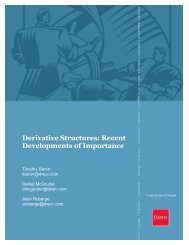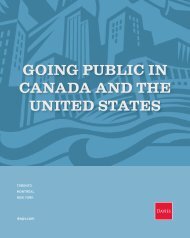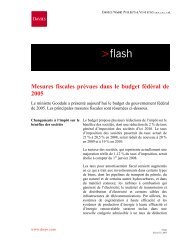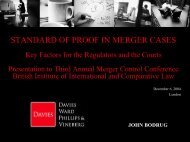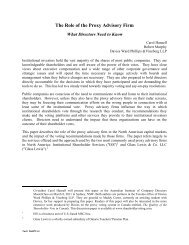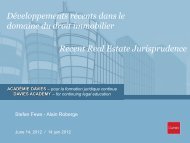doing business in canada - Davies Ward Phillips & Vineberg LLP
doing business in canada - Davies Ward Phillips & Vineberg LLP
doing business in canada - Davies Ward Phillips & Vineberg LLP
- No tags were found...
Create successful ePaper yourself
Turn your PDF publications into a flip-book with our unique Google optimized e-Paper software.
GENERAL RULESDeterm<strong>in</strong>ation of IncomeIn very general terms, <strong>in</strong>come for purposes of the Tax Act means <strong>in</strong>come from <strong>bus<strong>in</strong>ess</strong> or property, <strong>in</strong>comefrom office or employment and taxable capital ga<strong>in</strong>s.Income from <strong>bus<strong>in</strong>ess</strong> or property is generally equivalent to the profit from the <strong>bus<strong>in</strong>ess</strong> or property calculated<strong>in</strong> accordance with "well accepted pr<strong>in</strong>ciples of <strong>bus<strong>in</strong>ess</strong> (or account<strong>in</strong>g) practice" or "well accepted pr<strong>in</strong>ciples ofcommercial trad<strong>in</strong>g", adjusted as required by specific rules <strong>in</strong> the Tax Act.Income also <strong>in</strong>cludes one-half of the capital ga<strong>in</strong> (referred to as the taxable capital ga<strong>in</strong>) realized on a dispositionof capital property, subject to reduction by allowable capital losses. The amount of the capital ga<strong>in</strong> generallyequals the proceeds of disposition less the sum of the "adjusted cost base" of the property under the Tax Act(roughly the cost of acquisition) and any costs of disposition. If capital cost allowance (tax depreciation) hasbeen taken <strong>in</strong> respect of the capital asset, part of the proceeds may be ord<strong>in</strong>ary <strong>in</strong>come (a recapture of thecapital cost allowance previously claimed).Employment <strong>in</strong>come <strong>in</strong>cludes wages, bonuses and taxable employment benefits. Remuneration paid to directorsconstitutes <strong>in</strong>come from employment. Deductions from employment <strong>in</strong>come are very limited.Employers are required to make regular "source deductions" for <strong>in</strong>come tax and social security contributionsfrom employees' <strong>in</strong>come (<strong>in</strong>clud<strong>in</strong>g taxable benefits) and remit the amount to CRA on behalf of the employees.Directors of corporations may be personally liable if a corporate employer fails to make or remit sourcedeductions. Employers may also be required to pay prov<strong>in</strong>cial payroll taxes.The rema<strong>in</strong>der of this section summarizes some key rules relevant to the computation of <strong>in</strong>come for Canadiantax purposes and the taxation of common <strong>bus<strong>in</strong>ess</strong> entities.LossesCanadian rules do not permit formal loss consolidation or other relief with<strong>in</strong> a corporate group; however, thereare established techniques that have been accepted by CRA with<strong>in</strong> acceptable limits for shift<strong>in</strong>g losses betweenmembers of the same corporate group. The March 4, 2010 federal budget announced that the federalgovernment will explore whether a formal system of loss transfers with<strong>in</strong> corporate groups or consolidatedreport<strong>in</strong>g would be appropriate.Non-capital losses of a taxpayer from <strong>bus<strong>in</strong>ess</strong> or property can generally be carried back three years or forward20 years to reduce taxable <strong>in</strong>come of the taxpayer. Losses <strong>in</strong>curred prior to 2006 are subject to more restrictivecarry forwards.Net capital losses may be carried back three years or forward <strong>in</strong>def<strong>in</strong>itely, but generally can be applied onlyaga<strong>in</strong>st taxable capital ga<strong>in</strong>s.Various anti-avoidance rules may apply to limit the availability of losses, <strong>in</strong>clud<strong>in</strong>g those that may be utilizedafter an acquisition of control of a corporation.Interest Expense and Other F<strong>in</strong>anc<strong>in</strong>g CostsSubject to proposed loss limitation rules, reasonable <strong>in</strong>terest expense on funds borrowed or <strong>in</strong>debtedness<strong>in</strong>curred to acquire property for the purpose of earn<strong>in</strong>g <strong>in</strong>come from <strong>bus<strong>in</strong>ess</strong> or property is deductible on anaccrual or cash basis (depend<strong>in</strong>g upon the method regularly followed by the taxpayer).Non-<strong>in</strong>terest costs, <strong>in</strong>clud<strong>in</strong>g commissions and fees, <strong>in</strong>curred to borrow money or <strong>in</strong>cur debt for an <strong>in</strong>comeearn<strong>in</strong>gpurpose or to issue treasury shares are generally deductible on a straight-l<strong>in</strong>e basis over five years.Tax Considerations 83



